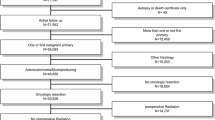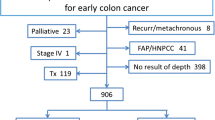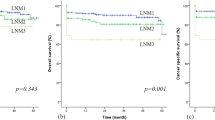Abstract
Purpose
Data evaluating the risk of lymph node metastasis depending upon the location of the primary tumor are limited in patients with T1 colorectal cancer. We aimed to evaluate the impact of tumor location on lymph node metastasis in T1 colorectal cancer.
Methods
Patients who underwent an oncologic resection with curative intent for T1 adenocarcinoma of the colon and rectum between January 1997 and October 2014 were assessed. Exclusion criteria were distant organ metastases, previous or concurrent cancer, past history of surgical or medical cancer treatment, preoperative chemoradiation, and patients with inflammatory bowel disease or polyposis syndromes.
Results
Out of 232 (56 % male) patients fulfilling the study criteria, 24 (10 %) had lymph node metastasis. Age (65 vs 61 years, p = 0.1), gender (55 vs 63 % male, p = 0.5), tumor size (2 vs 2 cm, p = 0.49), and lymphovascular invasion (5 vs 8 %, p = 0.46) were not associated with lymph node metastasis. While there was no statistical significance (p = 0.2), lymph node positivity was higher in rectal cancer (14 %, n = 11/79) compared to colon cancer (9 %, n = 13/153).
Conclusions
Although it was not statistically significant, lymph node positivity varies based on tumor location of T1 colorectal adenocarcinoma regardless of fundamental tumor characteristics including size, differentiation, and lymphovascular invasion.


Similar content being viewed by others
References
Nascimbeni R, Burgart LJ, Nivatvongs S, Larson DR (2002) Risk of lymph node metastasis in T1 carcinoma of the colon and rectum. Dis Colon Rectum 45:200–206
Morson BC, Bussey HJ (1970) Predisposing causes of intestinal cancer. Curr Probl Surg 1–46
Tanaka S, Haruma K, Teixeira CR et al (1995) Endoscopic treatment of submucosal invasive colorectal carcinoma with special reference to risk factors for lymph node metastasis. J Gastroenterol 30:710–717
Sakuragi M, Togashi K, Konishi F et al (2003) Predictive factors for lymph node metastasis in T1 stage colorectal carcinomas. Dis Colon Rectum 46:1626–1632
Wong SL (2009) Lymph node counts and survival rates after resection for colon and rectal cancer. Gastrointest Cancer Res 3:S33–S35
Okuyama T, Oya M, Ishikawa H (2002) Budding as a risk factor for lymph node metastasis in pT1 or pT2 well-differentiated colorectal adenocarcinoma. Dis Colon Rectum 45:628–634
Rasheed S, Bowley DM, Aziz O et al (2008) Can depth of tumour invasion predict lymph node positivity in patients undergoing resection for early rectal cancer? A comparative study between T1 and T2 cancers. Color Dis 10:231–238
Sjo OH, Lunde OC, Nygaard K et al (2008) Tumour location is a prognostic factor for survival in colonic cancer patients. Color Dis 10:33–40
Kawachi H, Eishi Y, Ueno H et al (2015) A three-tier classification system based on the depth of submucosal invasion and budding/sprouting can improve the treatment strategy for T1 colorectal cancer: a retrospective multicenter study. Mod Pathol 28:872–879
Khan S, Goh V, Tam E et al (2012) Perfusion CT assessment of the colon and rectum: feasibility of quantification of bowel wall perfusion and vascularization. Eur J Radiol 81:821–824
Kitajima K, Fujimori T, Fujii S et al (2004) Correlations between lymph node metastasis and depth of submucosal invasion in submucosal invasive colorectal carcinoma: a Japanese collaborative study. J Gastroenterol 39:534–543
Kobayashi H, Mochizuki H, Morita T et al (2011) Characteristics of recurrence after curative resection for T1 colorectal cancer: Japanese multicenter study. J Gastroenterol 46:203–211
Bhangu A, Brown G, Nicholls RJ et al (2013) Survival outcome of local excision versus radical resection of colon or rectal carcinoma: a Surveillance, Epidemiology, and End Results (SEER) population-based study. Ann Surg 258:563–565
Doornebosch PG, Gosselink MP, Neijenhuis PA et al (2008) Impact of transanal endoscopic microsurgery on functional outcome and quality of life. Int J Color Dis 23:709–713
Lee SW, Garrett KA, Shin JH et al (2013) Dynamic article: long-term outcomes of patients undergoing combined endolaparoscopic surgery for benign colon polyps. Dis Colon Rectum 56:869–873
Gorgun IE, Aytac E, Costedio MM et al (2014) Transanal endoscopic surgery using a single access port: a practical tool in the surgeon’s toybox. Surg Endosc 28:1034–1038
van den Boezem PB, Kruyt PM, Stommel MW et al (2011) Transanal single-port surgery for the resection of large polyps. Dig Surg 28:412–416
Lim SB, Yu CS, Jang SJ et al (2010) Prognostic significance of lymphovascular invasion in sporadic colorectal cancer. Dis Colon Rectum 53:377–384
Minsky BD, Mies C, Rich TA et al (1989) Lymphatic vessel invasion is an independent prognostic factor for survival in colorectal cancer. Int J Radiat Oncol Biol Phys 17:311–318
Wada H, Shiozawa M, Katayama K et al (2015) Systematic review and meta-analysis of histopathological predictive factors for lymph node metastasis in T1 colorectal cancer. J Gastroenterol 2015 [Epub ahead of print]
Kikuchi R, Takano M, Takagi K et al (1995) Management of early invasive colorectal cancer. Risk of recurrence and clinical guidelines. Dis Colon Rectum 38:1286–1295
Akagi Y, Adachi Y, Kinugasa T et al (2013) Lymph node evaluation and survival in colorectal cancer: review of population-based, prospective studies. Anticancer Res 33:2839–2847
Zong L, Chen P, Wang DX (2014) Death decoy receptor overexpression and increased malignancy risk in colorectal cancer. World J Gastroenterol 21(20):4440–4445
Storli KE, Søndenaa K, Bukholm IR, Nesvik I, Bru T, Furnes B, Hjelmeland B, Iversen KB, Eide GE (2011) Overall survival after resection for colon cancer in a national cohort study was adversely affected by TNM stage, lymph node ratio, gender, and old age. Int J Color Dis 26:1299–1307
Acknowledgments
The study was a poster presentation at the American Society of Colon and Rectal Surgeons Annual Meeting, May 30–June 3, 2015, Boston, MA. This study was supported by the Ed and Joey Story Endowed Chair in Colorectal Surgery. Erman Aytac is an assistant professor of surgery at the Acibadem University School of Medicine in Istanbul, Turkey.
Author information
Authors and Affiliations
Corresponding author
Ethics declarations
Conflict of interest
The authors declare that they have no conflict of interest.
Rights and permissions
About this article
Cite this article
Aytac, E., Gorgun, E., Costedio, M.M. et al. Impact of tumor location on lymph node metastasis in T1 colorectal cancer. Langenbecks Arch Surg 401, 627–632 (2016). https://doi.org/10.1007/s00423-016-1452-x
Received:
Accepted:
Published:
Issue Date:
DOI: https://doi.org/10.1007/s00423-016-1452-x




